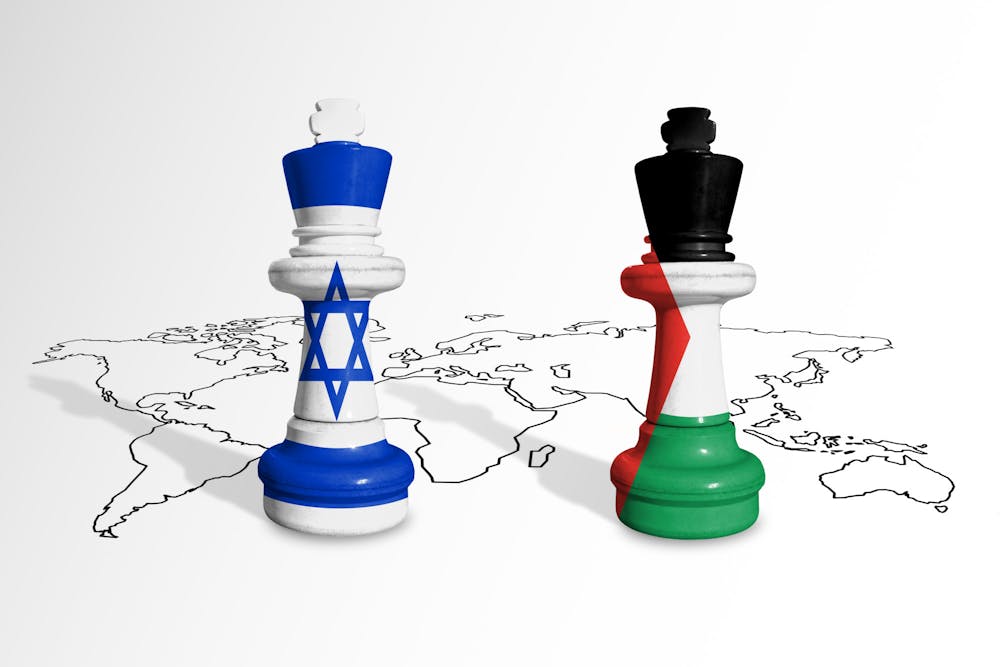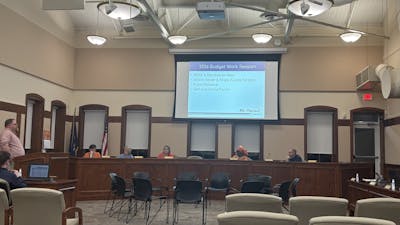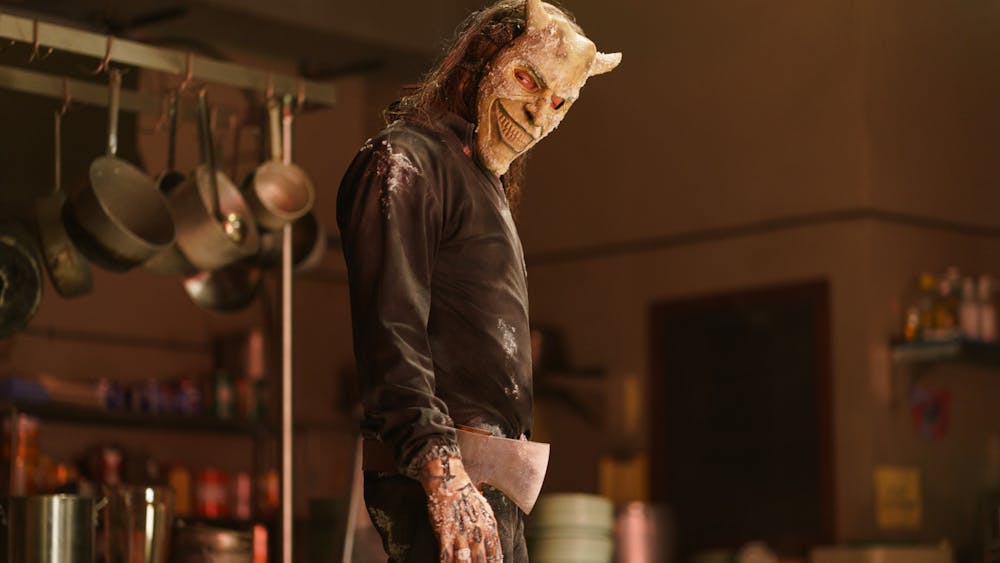Israel-Hamas war: Understanding the division through CMU historians
Part One: A historical overview of the centuries' long conflict
This story is the first in a four-part series looking at the Israeli and Palestinian conflict. Additional stories related to the impact of the war in the U.S. and on college campuses in Michigan and around the country will come. Read Central Michigan Life for more.
Editor's note: Senior Reporter Aurora Rae Abraham is Jewish and a former member of Hillel at CMU. In no way did this affect the reporting or writing of this story.
Here in the United States, "Israel and Palestine" pop up in the news every day since the Oct. 7 attack. However, this conflict has been ongoing for almost a century.
Many Americans have the privilege and luxury to go on with their lives. Meanwhile, the Palestinian civilian population in Gaza Strip has been cut off of food, water and fuel, while under the pressure of constant threat of military strike and relocation.
“(Americans) need to diversify the information … diversify and know the root of the problem of such people, know their story … (in order) to be fair,” Nahla Hamdan, a former Central Michigan University adjunct professor of Middle Eastern History from Lebanon, said.
So, what is actually happening in Israel and when did it take root?
The beginning
The history of the land dates back to around 1000 B.C.E. when the Kingdom of Israel was founded, Jason Szilagyi, CMU Middle Eastern history faculty member, said.
“For Israelis, they see this as the traditional homeland of the Jewish people,” Szilagyi said. “And they’re looking back with historical precedent.”
In the beginning of C.E., Romans came to the Israeli land, and after the second Jewish Revolt, known as the Jewish-Roman wars, the Israel Kingdom was wiped out. Romans expelled the Jewish population and renamed the land “Palestine."
“(Jewish people) do not actually have a permanent home country, they are displaced,” Szilagyi said. “As you have Romans moving … to fill the displaced, this is where we get the term Palestinians from. These are the people who start to inhabit the area after the Israelites are expelled.”
St. Claire freshman Michael Manson, a Jewish CMU student, said Jews were not removed from Israel by Palestinians, but rather the Romans.
“The Palestinians weren’t who kicked us out,” Manson said. “We were removed, and (Palestinians) just came in after us because that's how land works.
“We lived there thousands of years ago and we were forcibly expelled by the Romans and we were sent into diaspora,” they said. “But I also definitely understand why Palestinians want to be there, because they were there for a long time after the Jews were kicked out.”
The Roman Empire resided on the land until the early 6th century, when the Muslim Arabs conquered the territory, Szilagyi said.
However, the term Palestinian doesn’t refer just to Muslims, according to Shaheer Noor, CMU Muslim Student Association president.
“There’s Palestinian Jewish people, there’s Palestinian Christian people,” he said. “It just refers to people who lived in that area … they have been living (there) for hundreds and hundreds of years.”
Until the beginning of the 19th century, the area was ruled by different Muslim kingdoms, Prof. Szilagyi said. During the First World War, the territory was controlled by the Ottoman Empire.
Related content:
Israel-Hamas war: The impact on CMU’s community
Israel-Hamas war: Michigan universities respond in various ways
Israel-Hamas war: How does the conflict shape the U.S.?
How was Palestine split into two states?
Great Britain invaded the Ottoman Empire during the First World War and obtained the region of Palestine as a result, Szilagyi said.
They did that with the help of the Hashemite clan, who hoped that the Great Britan would give them Palestine when they seized it from the Ottomans.
However, the British government was negotiating with the French at the same time, Szilagyi said. As a result, the British and French split the Middle East, and the Great Britain got Palestine.
In 1917, the British Foreign Secretary was communicating with the World Zionist Organization, which had been trying to set up the Jewish home state.
“The British offer the World Zionist Commission … Kenya,” Szilagyi said. “(But there's) no historical precedent for a Jewish state because there has never been a large population in this area. The area that they are interested in is Palestine.”
As a result, the British cabinet promised the creation of a Jewish homeland in Palestine. On Nov. 2, 1917, then-British Foreign Secretary Lord Arthur Same Balfour wrote a letter to Lord Walter Rothschild explaining the arrangement, a passage now known as the Balfour Declaration.
When the First World War ended, Palestine became a British mandate state, which means that eventually it would become an independent nation.
“There (was) no plan ... put into place for this new state,” Szilagyi said. “And you have Palestinian Arabs who are upset about it. You even have the Zionists who are upset about it because there’s no timeframe for when the state is going to be created.”
In January 1933, Adolf Hitler was appointed Chancellor of Germany and within two months, the first concentration camp of the Holocaust opened, according to the St. Lous Kaplan Feldman Holocaust Museum. The Nazi German regime, its allies and collaborators murdered 6 million Jewish people, according to the United States Holocaust Memorial Museum.
"Jews themselves have been persecuted in Europe,” Hamdan said. “History is repeating itself over.”
More than 60,000 German Jewish refugees immigrated to Palestine during the 1930s, according to the Holocaust Museum's Holocaust Encyclopedia. But in May 1939, just two decades after promising Palestine as a Jewish homeland, Britain's Parliament approved a policy statement that severely limited Jewish entry into that same country.
Within a decade, Britain pulled out of Palestine.
“Britain decided that it was going to abandon Palestine,” Prof. Szilagyi said. “It no longer wanted to control that region and wants to withdraw in 1947 … Britain (turned) the mandate over to the United Nations and basically said that ‘this is going to be your issue now.’”

This map showcases the makeup of Israeli and Palestinian territories in 1947 and today. (Andrew Bootz | Presentation Editor)
Following the declaration, the United Nations came up with the Resolution 181, known as the Partition Plan. The plan splits the territory into a Jewish state and a Palestinian state.
“Both of these states are fragmented,” Szilagyi said. “And in many years … especially in the southern part of Palestine, ... beyond Gaza, going down towards the Red Sea, that’s mostly desert. So you really can’t (do) agriculture there.
"Each, the Israeli and Arab state … would be dead land.”
Jerusalem was supposed to be the United Nations’ mandated territory, an open city for everyone to worship in, he said.
Fires open between 1940s and 2023
However, the surrounding Arab states didn't recognize Israel, because they didn't want a Jewish country to exist in the Middle East. Lebanon, Syria, Iraq and Egypt launched the Arab-Israeli wars, Szilagyi said.
“What will end up happening is that instead of just taking this chunk they were supposed to, the Israeli military takes (other land) that was supposed to be Palestinian territories,” he said.
As Egyptians, Jordans and Syrians promised to protect the regions for the Palestinians, they “(had) no interest in setting up this Palestinian state,” Szilagyi said.
In 1960s, the Arab states were defeated.
Palestinians ended up at the refugee campus, where many still live today.
“Palestinian refugees never got a chance to actually set up the state,” Szilagyi said. “Fast forward, what ends up happening is that the Palestinians themselves, they have still never gained a recognition."
Meanwhile, Israel was building settlements in the Palestinian territories, Hamdan said.
“Settlements are illegal by international law,” Hamdan said. “They kept building settlements, and the settlers are aggressive. … In West Bank and Gaza, a lot of settlers were shooting Arabs.”
Soon Palestinian intellectuals and political leaders formed the Palestinian Liberation Organization, or PLO.
In 1990s, the Palestinian Authority and Israeli government tried normalizing the relationships, but not everyone supported that, Szilagyi said.
“There are going to be ultra-nationalists on both sides,” he said.
As some negotiated with Israel, others broke off and formed organizations known as Hezbollah in Lebanon and Hamas in Gaza Strip.
The tension continued, and both sides broke into violence several times throughout the subsequent period.
Hamas was founded in 1987 by a Palestinian refugee in Gaza, Sheikh Ahmed Yassin. The organization was formed to protest against Israel's rule in Gaza. Later, it seized control over Gaza from the official Palestinian Authority.
"The group has vowed to annihilate Israel and has been responsible for many suicide bombings and other deadly attacks on civilians and Israeli soldiers," the Associated Press reported.
While U.S. and the European Union recognized Hamas as a terrorist organization, Turkey, Qatar, Iraq and other Arab countried backed it up, according to the article.
"Hamas has always espoused violence as a means to liberate occupied Palestinian territories and has called for the annihilation of Israel," according to the AP.
What is happening in Gaza Strip today?
On Oct. 7, 2023, Hamas attacked Israel, and Israeli Prime Minister Benjamin Netanyahu declared war, according to the Associated Press reported.
“Media paints the Oct. 7 attack as completely … uncalled for … but you also have a history of what Israel has been doing to the civilians of Gaza and the West Bank and the Palestinians living in Israel,” Noor said. “This isn’t a one-sided thing.”
Noor believed the Israeli occupation and treatment of Palestinians was one of the reasons for the attack.
Gaza Strip, a territory of about the size of Detroit, is called an “air prison,” he said. That is because water, food and fuel resources are controlled by Israel; it has no job opportunities; it is watched and “tightly controlled,” Noor said.

As the presentation of Palestine Information Night comes to a close students get to ask seniors Mahim Hakim and Shaheer Noor questions, Wednesday, Dec.6, Pearce room 108. (CM-Life | Soli Gordon)
Mahum Hakim, the vice president of the CMU Muslim Student Association, said the Israeli government also controls electricity, hospitals and check points on the border.
“(Palestinians) can’t move freely in and out,” Hakim said. “(The blockade) also affects the aid that comes in from neighboring countries.”
Netanyahu ordered Israeli troops to enter Gaza, according to AP. Now, the Palestinians are facing a humanitarian catastrophe, the article reported.
Children make up almost a half of Gaza population, and they are the ones who suffer the most, according to UNICEF.
“They issue a death certificate before a birth certificate,” Hamdan said.
As Palestinians face food, water, medical shortages and bombing from Israel, 400 children die every day, both Noor and Hakim said. According to a Nov. 22 statement from United Nations World Health Organization Spokesperson Christian Lindmeier, about 160 children -- one every 10 minutes -- died each day during the first six weeks of the war.
AlJazerra reported that on Dec. 26 the death toll in Gaza approached 21,000. Just shy of 55,000 in Gaza were reported wounded as of Tuesday, and the revised death toll from the Oct. 7 attack on Israel stands at 1,139.
“And people are watching,” Hamdan said. “This is not acceptable by human standards.”
On Dec. 12, the United Nations called for “immediate humanitarian ceasefire,” according to UN News.
“It’s time for diplomacy,” Hamdan said. “(United States) should do a call for diplomacy, for real diplomacy.”







